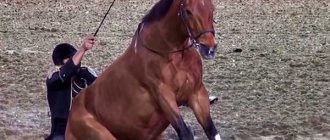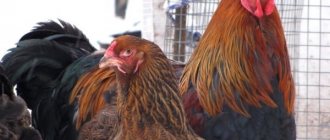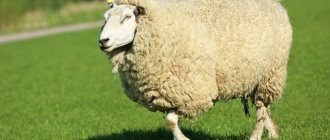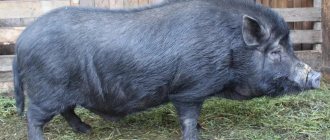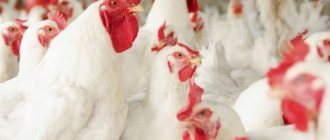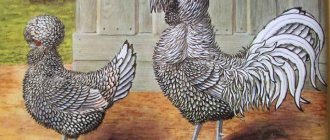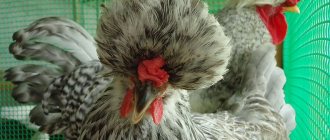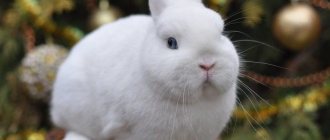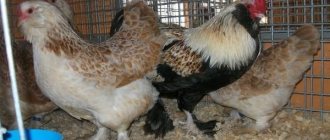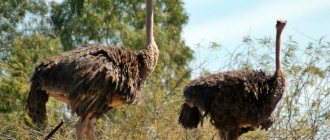The largest breeds of chickens differ from standard ones by their unusually large body weight, which sometimes reaches 5-7 kilograms. As a rule, representatives of such chicken species belong to the meat or meat-egg type, some of them have fighting roots. The weight of giants depends on the orientation of the variety, diet and living conditions in which they are kept. In the article we will look at the characteristics and features of the most famous large chickens.
Brahma
History and general information
In the 20-30s of the 19th century, a breed of Brahma chickens was created in the northern territory of America. Cochin and Malayan individuals were used to breed it. The choice of these two breeds was not accidental - one of them was distinguished by its large weight and high-quality meat, the other by its beautiful color and fighting character.
The breed of Brahma chickens finally received a standard in 1847.
In Russia, they learned about these chickens at the end of the 19th century. Since the mid-20th century, Brama has been one of the five common chicken breeds related to meat and egg production.
There are four subspecies of brahma, depending on the color of the feathers.
Partridge
It has light fawn colored plumage. The feathers have a triple outline in black and gray.
Roosters have a brick-colored head and back area, and black paws with a green tint. The crest of these chickens is small, but the leaf-shaped earrings hang below the beak.
Feature: the light brown shell of eggs of partridge laying hens has brown specks.
Light (Colombian)
The plumage is silvery-white. The tail feathers are black and there is a small collar of black feathers on the neck.
Chickens and roosters have a small comb. Distinctive feature: small head with highly developed brow ridges.
Dark
The feathers are black and white, the head is silver-gray. The body, limbs and paws are covered with black feathers. The collar area is white. A crescent moon forms on the chest with light plumage.
On the back, white alternates with black. In the bright sun, roosters' black feathers glow emerald.
Pale yellow
The feathers of hens and roosters are motley fawn. There is black plumage on the neck and tip of the tail.
Features: hens have practically no comb, while roosters have a pronounced one. Chicks of this subspecies can be born yellow and dark.
Weight, character and adaptive abilities
The young animals reach large sizes in a short time. Black and partridge males weigh up to 7 kg, the largest chicken of these subspecies can gain about 4.5 kg. Weight of white and dark cockerels - 5 kg, hens - 3.5 kg.
Over a period of 365 days, one hen produces about 120 eggs, each weighing 55 g.
Brahma giants are phlegmatic chickens, which allows them to get along calmly with other poultry. In addition, they are trusting and quickly get used to people.
Brahma chickens tolerate moderate cold well and can be allowed outside even in winter. The light in the coop should be on for at least 14 hours. Other nuances of keeping these birds can be found in the article “Breed of Brahma chickens.”
Description of popular fighting breeds
Popular breeds of roosters (photos and descriptions):
- Azil.
This word was used by the people of India to call almost all purebred breeds of roosters intended for fighting. Introduced to Germany in 1860, it is characterized by the following characteristics: strong muscles, stockiness, bonyness, angular shape, short legs, hard plumage and the pronounced character of a real fighter. Such a bird is considered to be fully formed and has reached sexual maturity in the 2nd year of life. - Araucana.
It is characterized by brown-red plumage with a black stripe along the feather shaft. The chest, legs and belly are black. A feature of the breed is taillessness - a dominant trait, inherited and caused by the absence of caudal vertebrae. Among experts it is believed that the tail interferes with combat. Roosters of the Araucana breed are very pugnacious. They reach 1.8 kg in size. A distinctive feature of the breed is the greenish-blue eggs that the hens lay. - Belgian fighting.
A fairly old breed of roosters (photo), bred approximately in the 17th century specifically for fighting. The homeland of such a large, courageous bird with an aggressive posture is Flanders. The back is horizontal, the tail is moderately developed. Weight from 4.5 to 5.6 kg, weight less than 4 kg is considered unacceptable. - Madagascar. They got their name from the island where they were bred by the natives. The bird is strong and hardy, widespread in Europe. Despite their menacing appearance, roosters are very friendly to representatives of other breeds and are even capable of raising chicks instead of a hen. The weight of the rooster is 2-5.5 kg. A characteristic feature of the breed is its bare neck and legs. Color black, red, white, brown.
- Lutticher. A strong, muscular bird with a broad-shouldered, elongated body and rough plumage. The head is powerful, with strongly convex eyebrows. The beak is curved, strong, the color of a dark horn. The chest is wide, somewhat convex. The wings are adjacent and long. The legs are long, bony, straight set. The belly is barely covered with wings, tucked up. The tail is slightly spread out, with good braids. The live weight of the rooster is 4-5 kg. The Lutticher bird has a very grumpy character and a gloomy expression on its “face”.
- Old English fighting. Representatives of this breed of roosters are characterized by strong muscles, a dense body, broad shoulders, covered with neck plumage. The chest protrudes noticeably forward and is rounded at the sides. The neck is long, strong, widening towards the back of the head. The legs are long, with muscular ankles. Set not very wide, they bend well at the joints. The spurs are firm, deeply set, and the hind toe is optimally attached to the ground. Males and females are practically no different in appearance, except that the hens have a better rear design and a fan-shaped tail. The Old English Fighting breed is temperamental, agile, and cocky. Easily adapts to any living conditions. Roosters are friendly towards their owners and have a negative attitude towards their rivals.
- Kulangi.
The breed of roosters (photo) is widespread in the countries of Central Asia. Such a bird is characterized by an even vertical carriage of the body, a strong build, and a small, well-sharpened beak. The neck is long, sinewy, slightly curved forward. The head is small, strong, slightly flattened on the sides. The comb is small, roll-shaped. The wings are small and fit tightly to the body. The plumage color is salmon, light brown and black. The legs are high, powerful, and constantly in a widely spread position. At the back there are sharp and very strong spurs. The color of the paws is light yellow, often with fine black pigmentation. The live weight of roosters is 4-7 kg. Due to their natural characteristics, roosters of this breed are very conflict-prone and do not tolerate the proximity of other breeds. The bird is adapted to training and can develop the necessary fighting qualities. - New England Fighting Modern. Brought out in England in 1850. Over the last century, after the veto of cockfighting, it has represented a decorative type of graceful structure. Roosters of the New England Fighting Modern breed are small. Weight - 2.0-3.5 kg. The body is wide, tapering towards the lower back. The plumage is short, angular, well defined and set back at the shoulders. The back is flat, strongly drooping, the neck is long. The wings are placed high and fit tightly to the body. The tail is narrow and small.
Master Gray
Origin
Another chicken record holder is representatives of the French hybrid breed Master Gray. Although some sources claim that the breed was developed in Hungary.
Breeders set themselves the task of creating a hybrid that can be kept in small farmsteads. Chickens are highly productive and do not require special care or feed.
Nowadays, several groups of breeders in different cities around the world are working to preserve the hybrid.
Appearance and egg production
The breed owes its name to its color (“gray” in English - gray) - the plumage consists of gray-white flowers. There is a “necklace” of dark gray feathers on the neck, and feathers of a darker shade on the edges of the wings and tail.
The comb and earrings of the chickens are painted bright red. The body is powerful, square in shape, with strong paws, developed bone and muscle apparatus.
Giants of the Master Gray breed of meat and egg type. Usually bred in private farms. Laying hens are characterized by high egg production - over 280 eggs per year, up to 90 g each. Chickens are characterized by early maturation; they begin to lay eggs at 4 months.
Live weight
A chicken weighs about 1.5 kg at 40-45 days, and 4 kg at six months. A huge rooster of the Master Gray breed can gain up to 6.5 kg, a chicken - 4.
The meat of these chickens has a dense and tender structure and is considered dietary.
It is better to keep birds in large aviaries or a chicken coop. However, when kept in cages, greater weight can be achieved. You cannot overfeed Master Gray chickens, otherwise the quality of the meat will deteriorate due to subcutaneous fat.
Parents are often unable to pass on high levels of productivity at the DNA level, so it is better to buy selectively selected chicks or hatching eggs. More information in the article “Master Gray Chickens: Description of the Breed.”
Overview of large meat birds
Among the available variety of breeds of domestic meat chickens, it is necessary to highlight the following favorites.
Broiler
For the first time, such a bird was obtained by English breeders by crossing two breeds that stood out for their weight and size. Today, on poultry farms, broilers are considered the most popular option, since they allow you to obtain inexpensive meat products in a fairly short time. Broiler is not officially registered as a breed, since such large individuals do not have persistent genetic properties that are subsequently transmitted to young animals. New meat types of broilers are constantly appearing on farms.
Jersey giant
The breed appeared not so long ago in America, in the state of New Jersey, due to which the individuals received this name. Large black birds, which were classified as meat crosses, took part in its development. Now birds are presented in different feather colors.
Chickens and roosters of this trend fully justify their name; they are distinguished by their rapid rate of weight gain, as well as early sexual maturity. As a rule, an adult male bird can weigh about 5-7 kilograms, while laying hens have a weight in the range of 4-5 kilograms.
Brahma
Most often, this breed is bred for the purpose of producing meat products, however, the birds also stand out for their productivity in terms of egg production. Due to their weight, these individuals are at the top of the list of the largest domestic birds.
Roosters and hens of this breed are distinguished by their visual attractiveness and have beautiful plumage, which also covers the limbs. In terms of feather color, birds can be either light or dark. The meat yield from roosters is within 6 kilograms, for laying hens - in the range from 4 to 5 kilograms. The meat has high organoleptic characteristics.
Master Gray
A hybrid of French origin, it got its name due to its beautiful gray-black plumage. The breed demonstrates excellent productivity in terms of weight gain; in addition, laying hens have high egg production rates. Typically, roosters suitable for slaughter will weigh around 7 kilograms, with hens a few kilograms behind.
Plymouth Rock
Birds of American origin, which received their name due to the place of breeding, as well as exterior qualities. The meat obtained from these birds is famous for its tenderness and taste. Chickens grow well and quickly, have endurance, and stand out with their proudly placed chest and thick plumage.
As for productivity, Plymouth rocks can be bred for both meat and eggs, however, the first direction still remains a priority. Birds rarely get sick and adapt well to any climate. Chickens usually lay eggs at the age of 5-6 months.
Cochin
Very large and at the same time beautiful birds. Individuals have feathering on their limbs, a large tail with prominent braids. Birds come in different feather colors and are positioned as one of the best among meat breeds. Roosters weigh about 5-6 kilograms, laying hens weigh about a kilogram less.
Orpington
A breed of poultry of English origin, bred in the 19th century. Initially, these were chickens with pure white plumage, but further selection led to the fact that the meat breed became quite remarkable due to its multi-colored plumage. The productivity of the species is distinguished by its high rates; male birds grow, reaching a weight of 5-6 kilograms, while laying hens will weigh about 4 kilograms. The birds also demonstrate good egg production.
Orpingtons have a large and proud build with a prominent chest, a red crest and earrings. The plumage of birds can be standard white, but also colored grey, black, brown, gold and hawk. The chicks gain weight quickly; in terms of care, the birds do not require the breeder to follow any complex rules.
Dorking
One of the most productive meat breeds, the birthplace of which is England. Chickens grow with a large body and large head, which sets them apart from most other breeds. Gender is usually determined by the position of the crest on the head - in roosters it will be erect, and in hens it usually hangs to one side.
Individuals are presented in a variety of feather colors, so in the farmstead you can find Dorkings with white plumage or birds in striped and iridescent colors. The breed is noted for its good weight gain, but the breeder will need to strictly control the diet of his birds, as they are prone to obesity. The taste and color of the meat in the future will directly depend on a well-designed chicken menu.
Jersey giant
Secrets of breeding
Many records for the weight of chickens and roosters belong to representatives of the Jersey Giant breed.
The first attempts to develop a new breed of chickens at the end of the 19th century were made by farmers John and Thomas Blackam, who crossed different types of black chickens for 20 years. However, the credit for breeding the breed was given to Uham Dexter. The year of birth of the breed is considered to be 1915.
During the selection, representatives of the Brahma, Orpington, Langshan, and Indian Fighting breeds were crossed. After 6 years, chickens of a new variety are imported to the UK, where they are improved with the help of British breeders. In 1922, the breed was officially registered.
In Russia, interest in the breed appeared only in 2000.
Productivity
Birds are rapidly gaining weight, and by the age of 6 months they reach their final levels: hens - about 4.5 kg, roosters - 5 kg. Afterwards, weight gain slows down, so further keeping Jersey chickens is not profitable.
It is advisable to keep only laying hens for longer, due to the annual egg production of 180 eggs, weighing up to 65 g. Due to their large weight, hens often crush eggs, although their maternal instinct is well developed. It is better to use an incubator to hatch chickens.
Appearance and temperament
The first birds of this breed had a black color, later chickens with white, blue and blue lace colors appeared. The body of chickens is elongated, with a wide back, legs, legs and thighs are strong.
The head of males is large, with a vertical leaf-like crest. But their main decoration is their bushy tail.
Jersey giants are balanced birds with a calm character. Finding themselves in new living conditions, they quickly adapt to them. Chickens are easy to care for and can live in spacious enclosures and small chicken coops. They tolerate cold well.
Due to their loose, thick feathers, Jersey chickens are prone to fleas and feather eaters. What else you need to know about these birds is described in the article “Jersey Giant Chicken Breed.”
Features of keeping and feeding large breed chickens
Breeding such giants is not a particularly difficult matter, but due to the large size of the individual, some nuances of maintenance should be taken into account.
- firstly, it is recommended to organize a spacious walk for the chickens;
- due to its heavy weight, the bird is not able to fly, which is why there is no need to install high fences;
- you should also arrange all nests and perches as low as possible, or install additional “ramps”;
- Laying hens often crush or throw out eggs, which is why strict control of the egg-laying process is required;
- the floor in the poultry house should be covered with soft flooring to avoid injury to chickens if they fall;
- These birds are distinguished by good cold resistance, but at the same time they have a rather vulnerable crest.
It is necessary to approach feeding chickens very responsibly; you should not overfeed them, since these giants are prone to obesity, which entails a decrease in the level of fertility.
Cochin
Place of origin and appearance
Indochina is considered the homeland of the Cochins. The birds are similar to Brahma chickens, which is not surprising, since they were used in the breeding of Cochins.
Interestingly, in China, the largest Cochin chickens were decorative, they were bred at the imperial court.
Cochins have lush, thick plumage, which helps them withstand frosts down to -20 degrees. Feathers cover the bird's entire body, even its paws and fingers. The comb is small, leaf-shaped, yellowish in color. The ears are long and red. The back is wide and short.
There are several varieties of the breed depending on the color of the feathers: black or vice versa - white, as well as blue, motley and partridge.
Cochins are calm and balanced birds. The first ones never get into a fight. But if someone threatens their offspring, they will rush to his defense without hesitation.
Productivity and Features
Cochins are a meat type of chicken. Roosters are massive and large in size, their weight reaches 5 kg. And large chickens lag behind them in weight by 1 kg. Their meat is considered healthy and dietary, and also has a unique taste.
Laying hens take a long time to mature and can produce no more than 130 eggs throughout the year. However, with the arrival of cold weather, egg production does not stop.
The price for Cochin chicken is high - starting at $10. Therefore, it is almost impossible to meet these chickens on ordinary farms.
In addition, the Cochin diet must be strictly monitored, since these chickens are prone to obesity, which significantly reduces the quality of meat and egg production. Other features are described in the article “Description of the Cochin chicken breed.”
Dream Interpretation - Chicken, rooster
Meat sheep breeds with photos and descriptions for breeding in Russia
The chicken is a restless bird, famous for its long clucking sound after laying an egg. The Rooster is the embodiment of courage and fighting nature, although in most cases these qualities turn into cockiness and pugnacity. Seen in a dream, these symbols are related to the household and the character of the people with whom the dreamer communicates. To see a dream in which chickens are looking for food, rummaging through money scattered in a thick layer around the yard is a harbinger of sad news or an event that may happen due to your negligence, try to focus on the main thing, and everything will be fine. Seeing a fairy-tale hut on chicken legs in a dream means you will be surprised. If you meet a person whose speech you cannot understand because it strongly resembles cackling, do not believe the rumors. Evil tongues will deceive you; Don't make hasty decisions under pressure. Seeing a chicken that sits unnaturally in one place for a long time means that they may soon turn to you for help, citing illness or disability, but you should not take everything for granted. Help so that you don’t regret participating in a person’s fate later. You dream of a chicken with a cow's udder - be careful: they are trying to deceive you, it is possible that the business that is being offered to you is an empty scam; do not believe those who promise big money and mountains of gold. To see a chicken that attacks a stranger who has entered an unfamiliar yard - the one who promises to provide support will not fulfill his promise; do not rely on the help of those who have not been personally verified by you. To dream of a garden bed being eaten by chickens - beware of a trick from careless family members, from children, from those who still do not know much. To dream of a pan of cabbage soup containing an unplucked rooster - you are warned of a surprise that will cause in you a storm of emotions of the opposite nature. In a dream, saving a hen that rushes to recapture its chick from a hawk is a symbol of the fact that your protector himself needs help. To dream that you have been pecked by a roast rooster - before making a final decision, weigh the pros and cons, because the dream foreshadows something unexpected for you. If in a dream you want to slaughter a rooster, then such a dream indicates that in your environment there are evil, envious people who are doing a lot of harm to you, even though you don’t know anything about it right now. Killing a rooster in a dream that prevents you from sleeping at night is a sign that you are too cunning and will suffer greatly because of this. Perhaps such a dream indicates that misfortune awaits you due to the cunning of a person close to you. Catching a rooster in a dream is a harbinger that you will soon have a difficult task ahead of you, which you are unlikely to be able to complete.
Orpington
The Orpington is also an English chicken breed - the result of the breeding work of William Cook. To breed it, the breeder used black Langshan, Plymouthrock, Sumatra and Minorca. The new species was named after Cook's estate, Orpington House.
Orpingtons are distinguished by their small stature, massive body, large shoulders and back. The wings and tail are short, with fluffy abundant plumage. The breed's varieties vary depending on the color of their feathers.
The meat of these giants is considered dietary and has a light color. Roosters gain up to 7 kg, and the largest chickens weigh 3.5 kg. Laying hens do not have a high egg production - about 150 eggs per year.
For productive and rapid growth, chickens need a high-quality ventilation system, since roosters can suffer from a lack of oxygen, especially in winter. More information in the article “Orpington chicken breed”.
Dream Interpretation - Huge dog
The dream is written out as from Miller's interpretation. A very colorful and transparent dream for interpretation. Just recently you made an influential friend. In some cases, the size of the dog may indicate the degree of your affection, and not its influence. In this case, the dream carries information about your desire to please this new acquaintance. It should also be noted that this friend may not be so new, but his role in your eyes has changed quite recently. You are slightly wary of him, although you have high hopes for the relationship. Trying on clothes means looking at him as a partner or even a companion. And the most interesting aspect. His collar is torn - this may indicate that he is divorced or that today his heart is in search. A different interpretation of this point suggests that you may lose it if you do not take measures to restore parity in the relationship in the near future. This means that you must become as necessary to him as he is to you. The dream suggests that there is no need to be afraid of urgent changes, but delays in this matter are fraught with losses. Figure it out with yourself, who is this big and shaggy dog and is he ready to try on the clothes you sew? Good luck! Sincerely, Diver. Interpretation of dreams from the Dream Interpretation of the House of the Sun
Broilers
Broilers are hybrids obtained by crossing different breeds. Such chickens are bred for cheaper meat.
Broilers are not a separate breed, but a variety of chicken with loose genetic characteristics. That is, the resulting selection result does not appear in the next generation.
Every year new hybrids appear using representatives of giant chicken breeds. They are not picky about food and living conditions, and are resistant to diseases.
The most popular broilers are:
- Ross-708: at the age of 35-37 days, weight reaches 3 kg;
- Ross-308: at the age of 41-64 days, weight - 2 kg;
- Cobb-500: at the age of 39-43 days, weight - 2.5 kg;
- Broiler-61: at 39-43 days weight - 1.8 kg.
To decide on the choice of the best broiler, we recommend that you read the article “What is the difference between broilers Cobb-700, Ross-308 and Ross-708.”
Philosophy of beauty
So, few will deny that chicken is not always trivial: “egg or meat,” although in the sense of gastronomic perception it is more common. What if you try to change the viewing angle and look at the heroine of our review differently?
Agree, its undeniable advantages become clear, and suddenly it becomes apparent that this creature is very, very good-looking. An elegant arsenal: an amazing fluffy tail, a magnificent comb, “feathery boots” - why not decorate any backyard, front garden and aviary?
Let's take a closer look at the decorative beauties that have confidently established themselves as a distinctive segment of the poultry industry. Watch the video of the most unusual breeds of chickens.
Conclusions and weight record holders
All the breeds described above belong to varieties of giant chickens, but their weight varies slightly. What does the weight table for adults, over 1 year old, chickens and roosters of the listed breeds say:
Based on the data in the table, we can conclude that the largest breed of chicken is Brama, which is the leader in weight among both sexes of birds.
It is difficult to indicate the weight of broilers per year, since keeping these chickens for more than 3 months is unprofitable. After all, by this age they reach their maximum weight and go to slaughter.
Let's name the world record holders for weight among roosters.
Rooster Coburn is a Brahma breed. The largest rooster in the world weighed 11 kg at the time the record was set. Its height was 91 cm.
Weardo is a Whitesulli breed. Had a mass of 10 kg.
Big Snow is a whitesulli breed, height - 47.2 cm, weight 10.51 kg.
Characteristic
Girls are ready to deal with the consequences of their actions, even if they have to pay a high price. They are one of the calmest people among all the zodiac signs. They have an ideal internal balance that has no equal.
Optimistic and tender, have a good taste. They are sophisticated people and people always ask them for advice and opinions on how to dress and take care of their hair. The woman talks a lot and on different topics. She knows how to behave in society and is always open to conversation.
Sensitive Libra-Roosters are great intellectuals and can charm anyone. Ladies are skillful and accurate, have an analytical mind, and know how to judge a situation clearly, regardless of the circumstances.
Interested in their own appearance and how others perceive them. For them, the most important things in life are family, health and home. They try to surround themselves with smart and influential people. Words in any conversation are chosen carefully before they decide to say anything.
Appreciating everything that surrounds her, such a woman is calm, she is able to understand the point of view of other people. For this reason, she always has many friends. Calm and mature, very smart. She approaches various situations with tact, and only takes tough action when required. Psychologists recommend that she not express herself openly and rudely, since such behavior is not typical for this sign.
If I were more observant, I would learn to use this to my advantage. This girl needs to feel freer to be happy. You can't criticize her too much because you might offend her.
Don't be fooled by this lady's cheerfulness, she is not the kind of person who will trust others easily, regardless of whether the other person is polite or not. If you manage to gain a little trust, a woman will easily tell you about every detail of her life. The desire to share can be interpreted as a weakness of character, since such revelation often leads to disappointment.
The fact that they like to talk so much can work against them. When something bothers a Libra girl, she speaks much faster.
Fourth place - rhea
Rhea The Nandu is a large bird native to South America.
The height of the rhea reaches 1 m 40 cm, and the weight is 40 kg. The appearance is peculiar - the massive body is densely covered with lush feathers, the small head is supported on a long feathered neck, the high bare legs are equipped with three fingers, and the small wings have a sharp claw. The rhea uses these claws to protect itself from enemies. Interesting: 10 most aggressive animals on the planet - list, description, photos and videos
The bird compensates for its inability to fly by running fast. When spread, the wings help maintain balance and act as a sail on windy days. In case of danger, rheas reach a speed of 60 km/h; they are also good swimmers and can easily cross rivers.
Photo gallery
Photo 1. Rooster Coburn in his chicken coop
Photo 2. Interesting color of Orpington chickens
Photo 3. Jersey giant on a walk
Giant laying hens
Among egg-laying breeds there are also individuals that stand out among ordinary laying hens for their size.
Gilan bird
One of the oldest breeds, therefore, determining its homeland today is very difficult. The most common information is that the bird still comes from Iran. Laying hens and roosters are notable for their unique appearance; individuals develop, while significantly increasing in height. The body of the birds is set vertically, the limbs and neck are extended, the paws are stable. The Gilan chicken has very developed muscles, so individuals of this species were initially bred as fighting chickens.
As for the maternal instincts of chickens, they have a well-developed brooding instinct, and subsequently they are characterized as caring mothers. Roosters jealously defend their territory. The weight of Gilan birds varies between 5-10 kilograms. Laying hens mature quite late, so their first laying occurs no earlier than the hen reaches one year of age. As a rule, one laying hen produces about 150-160 eggs per year. The eggs stand out for their large size and strong shell. The weight of one reaches 70-80 grams.
Chickens can withstand low temperatures and retain the ability to hatch eggs throughout the season.
Malin
Large birds of Belgian origin that stand out for their cuckoo-like coloration. Several meat and egg breeds took part in the selection of the breed. Today, the laying hen is found on farms around the world. The weight of a rooster can reach up to 6 kilograms, chickens usually weigh about 5 kilograms.
Birds are very sensitive to low temperatures, so keeping them requires strict control of air temperature and humidity. During the laying process, laying hens will need to provide additional vitamins to their diet. However, laying hens are not always distinguished by the presence of maternal instinct. On average, one female produces about 150 eggs per year, the weight of which varies within 60 grams.
Corniche
The breed has been raised by humans for a very long time to produce meat and egg products; individuals are notable for their ability to gain weight even with minimal feeding. The color of the plumage of birds is predominantly white, but there are birds with dark patches in color. In terms of their structure, the Cornish differs from other breeds in that it has a small tail and beak, while the body will be massive and the neck will be wide and long.
Work on improving the breed has made it possible today to use it for further selection of poultry with high productivity characteristics. Chickens of this breed are capable of laying eggs up to three years of age, the average egg production is about 165-170 eggs per year.
Dominants
This breed is used to produce environmentally friendly products in Switzerland. Dominants can be bred by both experienced and novice breeders. Chickens are hardy and perfectly adapted to different climatic conditions. They live well in heat and severe frosts. Another feature can be called undemanding to the food supply. Dominants can obtain useful elements from any low-grade mixtures. The breed has a good immune system and is not susceptible to colds and viral diseases. Birds tolerate diseases very easily and recover quickly with proper treatment.
Dominants
Egg production is 320 eggs in 365 days, the average weight of one egg is 70 grams. If you provide birds with a balanced diet, you can achieve increased productivity.

